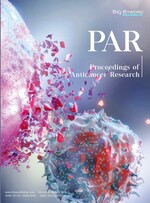Abstract
Objective: To explore the mechanism by which macrophages secrete CCL22 to promote the metastasis of triple-negative breast cancer under hypoxic conditions. Methods: 20 ng/mL mass concentration of phorbol 12-myristate 13-acetate (PMA) cell culture medium, 4?,6-diamidino-2-phenylindole (DAPI), dimethyl sulfoxide (DMSO), trypsin digestion solution, CCL18 Kit , Interleukin (IL)-10 Kit, CCL17 Kit, CCL22 Kit, TRIzolTM Reagent Reverse Transcriptase Polymerase Chain Reaction (RT-PCR) Kit, triple-negative breast cancer cells MDA-MB-231 and BT-549, as well as other reagents were used to culture triple-negative breast cancer (TNBC) cells MDA-MB-231 and BT-549 as well as human mononuclear cells THP-1, analyze and observe the metastasis of triple-negative breast cancer cells to the lungs, the secretion of CCL22, the migration of triple-negative breast cancer, and the situation of CCR4. Results: Compared with normal tumor-associated macrophage (TAM), hypoxic TAM further promoted the migration of tumor cells. The number of tumor metastases in the lungs, induced by hypoxic TAM, was significantly higher than that of normoxic TAM. Hypoxia can significantly stimulate the expression of CCL22. CCL22 can significantly promote the migration of MDA-MB-231 and BT-549 cells. The expressions of CCR3, CCR4, and CCR5 in tumor tissues were significantly increased compared with normal tissues, in which CCR4 showed the most significant increase. Conclusion: TAM cultured under hypoxia significantly enhanced the migration ability of TNBC cells and promoted the metastasis of cancer cells to the lungs in vivo. The hypoxic condition induced TAM to secrete CCL22; the expression of CCL22 receptor, CCR4, in breast cancer tissues was significantly higher than that in normal tissues.
References
Xu S, Zhang Z, Zhang X, et al., 2022, Study on the Correlation Between the Prognosis of Neoadjuvant Chemotherapy for Triple-Negative Breast Cancer and the Expression of Ki-67 and TOPK. Advances in Modern Biomedicine, 22(08): 1514–1518.
Zhang M, Liu W, Wang L, et al., 2022, The Relationship Between BRCA Gene Mutation and the Prognosis of Triple-Negative Breast Cancer Targeted Therapy. Journal of Clinical Military Medicine, 50(04): 397–399.
Yao S, Zhang J, Liu Y, et al., 2022, Expression and Clinical Significance of CD44v6 Before and After Neoadjuvant Chemotherapy in Triple-Negative Breast Cancer. China Coal Industry Medical Journal, 25(02): 162–166.
Chen F, Liu F, Wu N, et al., 2022, Inhibitory Effect and Mechanism of Novel Recombinant Myricetin on Triple-Negative Breast Cancer. Journal of Bengbu Medical College, 47(04): 426–432.
Jamiyan T, Kuroda H, Yamaguchi R, et al., 2022, CD68 and CD163 Positive Tumor-Associated Macrophages in Triple-Negative Breast Cancer. Journal of Clinical and Experimental Pathology, 38(03): 277.
Lei H, 2022, MCM7 Gene Expression and Clinical Significance in Triple-Negative Breast Cancer Patients Before and After Neoadjuvant Chemotherapy. Chinese Journal of Gerontology, 42(06): 1337–1340.
Li Z, He Y, Tang J, 2022, Expression of HIF-1? and MALAT-1 in Triple-Negative Breast Cancer and Their Correlation Analysis. Henan Journal of Surgery, 28(02): 58– 60.
Zhong L, Wang J, Zheng H, 2022, Clinicopathological Significance of CD4, CD8, Foxp3 and PD-L1 Expression in Stromal Tumor-Infiltrating Lymphocytes of Triple-Negative Breast Cancer. Journal of Clinical and Experimental Pathology, 38(03): 278–283 + 288.
Pei D, Li B, Dai X, et al., 2021, Expression of EGFR and VEGFR in Triple-Negative Breast Cancer and Their Correlation with Pathological Features. Jiangxi Medicine, 56(11): 1942–1945 + 1958.
Zou Q, Zhou Y, Zhen Y, 2021, Expression and Prognosis of AR and ki67 in Triple-Negative Breast Cancer. Medical Diet and Health, 19(18): 160–161.
Wang R, 2021, Lnc01094/miR-877-5p/Del-1 Axis Promotes the Occurrence of Malignant Phenotype in Triple-Negative Breast Cancer, thesis, China Medical University.
Li L, Zhang Z, Pan B, et al., 2021, Based on PI3K/Akt/mTOR Signaling Pathway to Investigate the Effects of Shugan Jianpi Jiedu Recipe-Containing Serum on the Proliferation, Migration and Invasion of Triple-Negative Breast Cancer MDA-MB-231 Cells. Chinese Journal of Experimental Formulas, 27(15): 22–28.
Zhang P, Zhong X, Zheng H, et al., 2021, Expression and Significance of Spindle Checkpoint Protein BUB1B in Triple-Negative Breast Cancer. Chinese Journal of Pathology, 50(06): 645–649.
Tian X, 2021, Relationship Between PELP1/MNAR Expression and PIK3CA Gene Mutation in Molecular Subtypes of Breast Cancer, Datong Fifth People’s Hospital, Shanxi.
Mi X, 2021, Screening of EMT-Related RNAs in Exosomes of Triple-Negative Breast Cancer Stem Cells, Jilin Provincial People’s Hospital, Jilin.
Huang X, 2021, The Relationship and Significance of PD-L1 Expression and Epithelial-Mesenchymal Transition in Triple-Negative Breast Cancer, thesis, Kunming Medical University.
Mi M, Wei X, Jiang H, et al., 2021, Research Progress on the Mechanism of LncRNA in the Occurrence and Development of Breast Cancer. Laboratory Medicine and Clinic, 18(06): 844–847.
